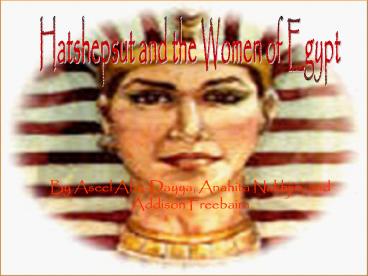Hatshepsut and the Women of Egypt - PowerPoint PPT Presentation
1 / 7
Title:
Hatshepsut and the Women of Egypt
Description:
... was sent with 5 ships with 30 rowers in each over the Red Sea from Quseir, Egypt. ... of incense, eye-cosmetics, with apes, monkeys, dogs, and with skins of the ... – PowerPoint PPT presentation
Number of Views:375
Avg rating:3.0/5.0
Title: Hatshepsut and the Women of Egypt
1
Hatshepsut and the Women of Egypt
By Aseel Abu-Dayya, Anahita Nakhjiri, and Addison
Freebairn
2
The Royal Family
- Hatshepsuts was born to King Thutmose I and
Queen Ahmose. Hatshepsut eventually married her
stepbrother, Thutmose II, whom she ruled the
throne with until his death in 1479 B.C. From
him, she bore two daughters, Neferura and
Merira-Hatshepsut. Neferura was, like her mother,
raised like a boy, although she was technically a
princess. Her other daughter, Merira-Hatshepsut,
eventually became the wife of Thutmose III, the
son of Thutmose II, from a previous marriage. By
theory, Amenhotep II, was also believed to be the
third daughter of Hatshepsut. After the
death of Thutmose II in 1479 B.C., Hatshepsut
ruled along with her stepson, due his young age.
It wasnt until 1473 B.C., when Hatshepsut
declared herself pharaoh and took up the throne.
In 1458 B.C., Hatshepsut mysteriously
disappeared, but many believe that is was
Thutmose III seeking revenge of his earlier
capture of the throne. s
3
Her Obelisk in Karnak
- One of Hatshepsuts greatest creations was her
construction of her obelisk, a tall, four-sided
shaft of stone, which rises to a pointed pyramid
top, in Karnak, Luxor Egypt. It weighs
approximately 320 tons and 97 feet high. Her
obelisk was carved from red granite from single
pieces of stone. On the base of this obelisk, in
32 lines of hieroglyphs, which state what
happened during the building of this obelisk.
4
The Deir el-Bahri Temple
- One of Hatshepsut main accomplishments...is
her temple, also know as her funerary complex,
located in Deir el-Bahri Egypt. Built by her
architect Senenmut, the temple was set and built
at the head of a valley overshadowed by the Peak
of Thebes, where a goddess was living. An avenue
of sphinxes lined up and led up to the temple,
where many ramps also led from terrace to
terrace. Also lined up inside of the temple, are
statues of Hatshepsut smiling over the valley,
with other statues and sphinxes.
5
The Expedition to Punt
- Hatshepsuts expedition to Punt, also known as
the Gods land, was on her 8th year of reign and
was a great accomplishment at the time. On the
expedition, her architect, Senenmut, was sent
with 5 ships with 30 rowers in each over the Red
Sea from Quseir, Egypt. They left for a trading
mission, for myrrh trees, and for items used to
make cosmetics for religious ceremonies. But not
only did they come back with their desired items,
they came back with exotic plants and animals,
completely loading their ships with items. This
quote, to my right, indicated how much power
Hatshepsut had over the people of Egypt, and
getting anything that she desired.
all goodly fragrant woods of God's-Land, heaps
of myrrh resin, with fresh myrrh trees, with
ebony and pure ivory, with green gold of Emu,
with cinnamon wood, khesyt wood, with two kinds
of incense, eye-cosmetics, with apes, monkeys,
dogs, and with skins of the southern panther,
with natives and their children. Never was
brought the like of this for any king who has
been since the beginning.
6
Hatshepsut
- Hatshepsut Maatkare was the fifth ruler of the
18th dynasty, and one of the few female pharaohs
of Egypt. She was one of the very few queens who
have ever sat on the throne of Egypt, and
surprisingly, was the only one to be enthroned as
a king, not a queen, bearing all the divine
names of a king. Assuming all the regalia and
ceremonies of a true Pharaoh and dressing in
men's attire, including having a beard,
Hatshepsut administered affairs of the nation,
with the full support of religious leaders.
However, Hatshepsut was defaced from most of her
monuments, and many reliefs were smashed,
obliterated, or vandalized. The ignoring of her
name in all Kings Lists has made her
unremembered for a long period, and constituted
some later difficulties for historians. She was
later remembered once again during the 19th
century A.D., with the study of her temple in
Deir el-Bahri.
7
Bibliography
- Authors Last Name, First Name. Title. URL,
Date Accessed. - Example DiStefano, Vince. "Guidelines for
Better Writing." Available - http//www.usa.net/vinced/home/better.html,
January 9, 1996 - Seawright, Caroline. Hatshepsut, Female Pharaoh
of Egypt. http//www.touregypt.net/historicalessa
ys/hatshepsut.htm, May 20, 04. - Arab, Sameh. The Queens Of Egypt Hatshepsut.
http//www.touregypt.net/magazine/mag02012001/magf
1.htm, May 19, 04.































